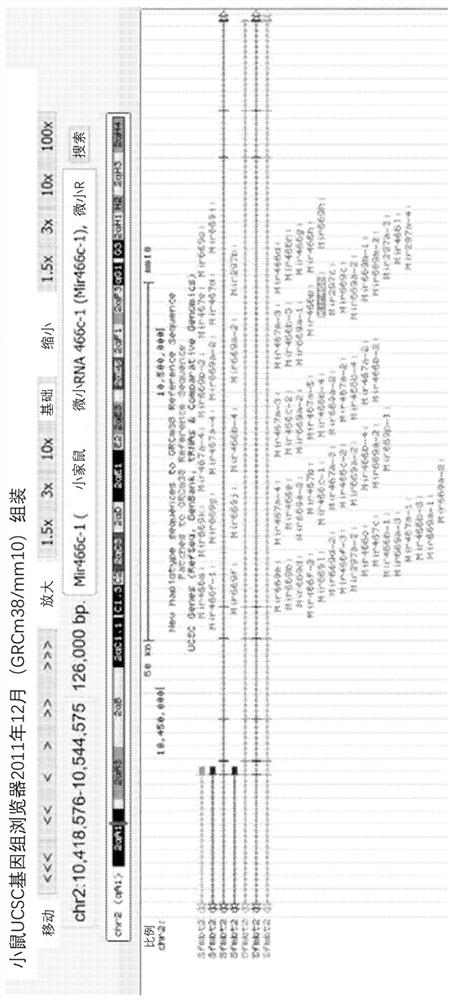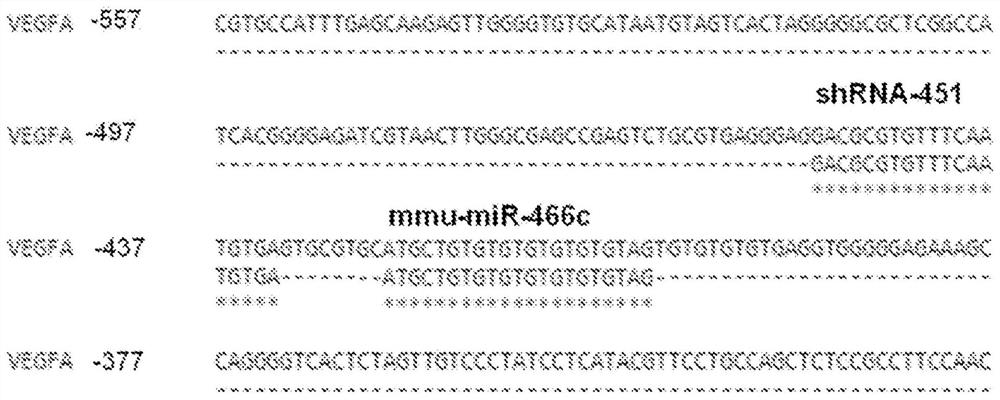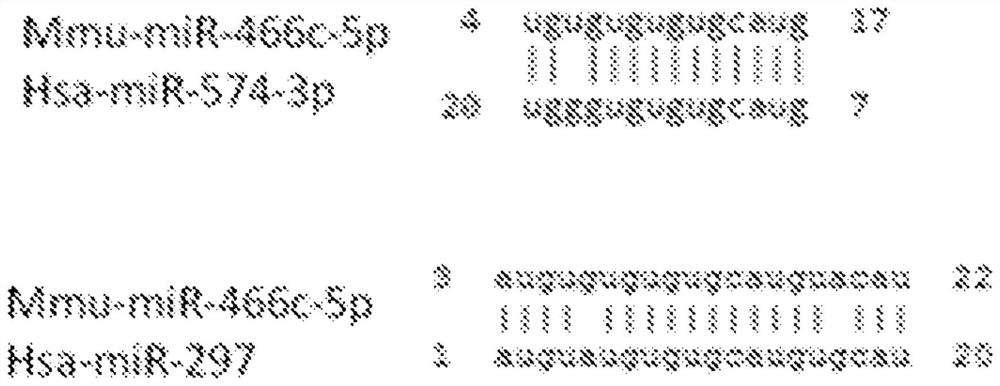Synthetic microrna mimics
A technology of composition and vehicle, applied in DNA/RNA fragments, recombinant DNA technology, medical preparations containing active ingredients, etc., can solve the problems of weak delivery efficiency, tumor occurrence, and undeveloped VEGFA therapy.
- Summary
- Abstract
- Description
- Claims
- Application Information
AI Technical Summary
Problems solved by technology
Method used
Image
Examples
Embodiment 1
[0202] Example 1. Deletion of mmu-miR-466c abolishes Vegfa expression in hypoxic endothelial cells
[0203] To analyze the role of mmu-miR-466 in regulating Vegfa in response to hypoxia, CRISPR-mediated gene editing was used to remove a 97 bp region from intron 10 of Sfmbt2 containing the mmu-miR-466 hairpin. Vegfa expression is known to be upregulated in hypoxia. The normally observed induction of mmu-miR-466 expression under hypoxia was not present after removal of mmu-miR-466 ( Figure 4 A). The expression of the parental gene Sfmbt2 was also no longer induced in response to hypoxic stimulation ( Figure 4 B). Importantly, the upregulation of Vegfa expression in response to hypoxia was also abolished when miR-466 was removed ( Figure 4 C). When miR-466 levels were restored using lentiviral transduction, Vegfa levels increased equally under normoxic and hypoxic conditions, but hypoxia did not further induce Vegfa expression ( Figure 4 D).
Embodiment 2
[0204] Example 2. Generation of mmu-miR-466c-deleted cell lines by CRISPR / Cas9
[0205] To remove mmu-miR-466c from intron 10 of Sfmbt2, the two guide RNAs were cloned into separate expression plasmids (pcDNA-H1-sgRNA, see Figure 9) and transfected into C166 cells using Nucleofector I (Amaxa) together with a Cas9 plasmid co-expressing GFP (PX458, catalog number 48138, Addgene). CRISPR is guided to the side of the deletion by guide oligomers (SEQ ID NO: 9-12) such as disclosed in US8697359B1. Based on GFP positivity, single cells were sorted into 96-well plates using sorting FACS (BDFACSARIA III cell sorter) and established clonal cell populations. Cultures were typed by PCR to identify cells containing the desired deletion, and positive clones were further confirmed by Sanger sequencing.
[0206] Table 1. Forward and reverse guides designed to target miR-466c flanking regions
[0207]
[0208] Table 2. Primers used to type miR-466c deletion
[0209]
Embodiment 3
[0210] Example 3. mmu-miR-466c regulates VEGFA in human cell lines
[0211] To test whether murine miR-466c may have any effect on the mRNA levels of human VEGFA, the inventors transfected human Ea.hy926 and ARPE-19 cells with a synthetic miR-466c mimic.
[0212] A t-Student test in Ea.hy926 samples treated with the hairpin form miR-466c-3p mim revealed that VEGFA mRNA levels were significantly reduced when compared to negative control transfection (Negative Control siRNA Cat# AM4611, Ambion). ( Figure 5 ). The miR-466c-3p mimic was able to downregulate VEGFA by inducing an approximately 3-fold downregulation (0.296-fold change). The same effect was observed when cells were treated with a single-stranded ssRNA-466c-3p mimic that was able to downregulate VEGFA by inducing approximately 1.42-fold downregulation when compared to negative control transfection (0.697-fold change) ( Figure 6 ).
[0213] In contrast, when testing the hairpin mimic 5p (miR-466c-5p mim) and the s...
PUM
 Login to View More
Login to View More Abstract
Description
Claims
Application Information
 Login to View More
Login to View More - R&D
- Intellectual Property
- Life Sciences
- Materials
- Tech Scout
- Unparalleled Data Quality
- Higher Quality Content
- 60% Fewer Hallucinations
Browse by: Latest US Patents, China's latest patents, Technical Efficacy Thesaurus, Application Domain, Technology Topic, Popular Technical Reports.
© 2025 PatSnap. All rights reserved.Legal|Privacy policy|Modern Slavery Act Transparency Statement|Sitemap|About US| Contact US: help@patsnap.com



